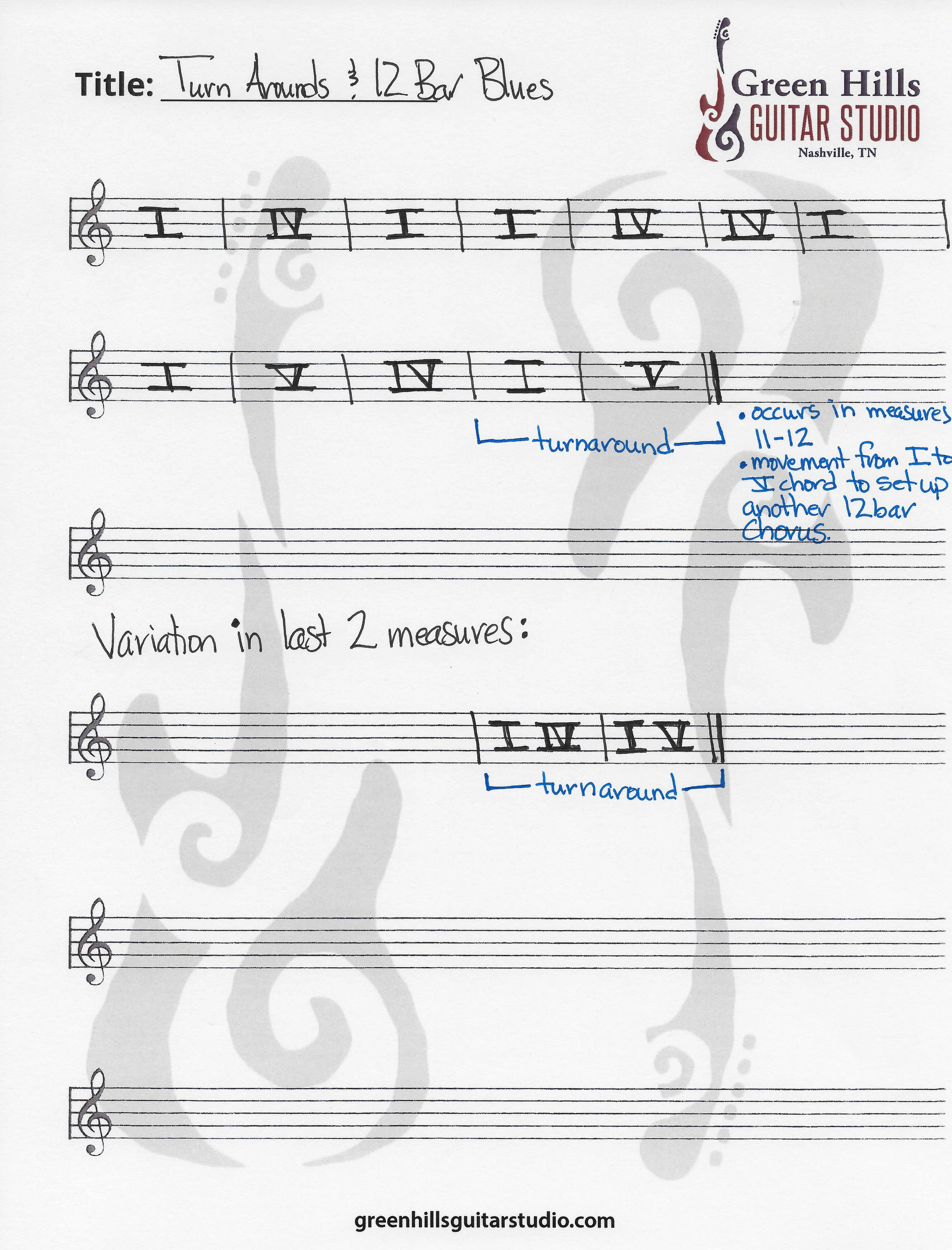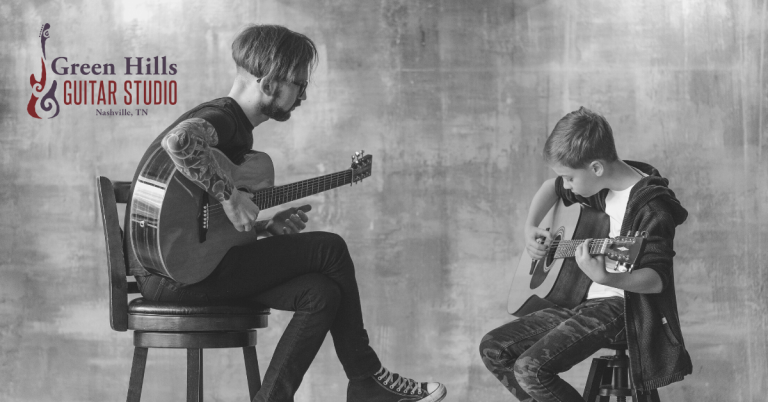Turning the Tune: Demystifying Musical Turnarounds
So, what’s a turnaround in music? Think of it as a cool twist in the melody—a musical U-turn. These little things spice up the tunes and are key players in various music styles. From blues vibes to jazzy beats, turnarounds keep things interesting.
Picture this: the last two beats of a 12-bar blues jam. That’s where turnarounds love to shine. But hey, blues isn’t the only game in town. There are other chord progressions, but we’ll dive into those at a later time. For this article, we’ll zoom in on the last two beats of the standard blues progression and see how turnarounds work their magic.
But first, let’s cover a little background on the musical turnaround.
What is a Turnaround in Music?
A turnaround in music is like a plot twist, a musical maneuver that gives a tune its unique flavor. Its job? To set the stage for a musical section to happen again. Imagine it as the backstage crew getting everything ready for the main act to make a comeback.
Musical turnarounds aren’t shy—they pop up in different parts of a song, making their mark in intros, verses, solos, and even endings. They’re the architects of anticipation, telegraphing the conclusion of a chord progression and helping to build up the excitement of a piece.
So, in a nutshell, turnarounds are the secret sauce of a song, adding that extra oomph and setting the stage for what’s coming next. Whether you’re nodding along in the crowd or strumming your guitar, recognizing turnarounds will add a whole new layer to your musical understanding.
Historical Roots of Turnarounds
Take a musical journey back to the Renaissance period (around 1400-1600), and you might find some comfort—or perhaps a hint of pressure—in discovering that the familiar move from the 5 (V) chord to the resolving 1 (I) chord existed as early as the mid-1500s.
Back then, harmony and chord progressions weren’t as big of a focus as they are now. Music was all about linear, standalone melodies, a style known as polyphony, where different lines played independently.
Imagine monks or country folks singing their own tunes. Now, shift your perspective from a melody-focused view to a harmony-focused one. Surprise! What emerges is harmony—actual chords forming from those seemingly independent melodies.
For a more adventurous Friday night, explore modal English folk tunes from this era. Listen closely, and you’ll catch how the vocal lines and music hinted at changes, setting the stage for what would come next.
Moving forward, the Baroque period (around 1600-1750) stepped onto the stage. Here, both homophonic music (melody with chordal harmony) and polyphonic music found a place. Did the 12-bar blues spark a musical revolution even back then? Let’s dig in and find out!
Turnarounds in Blues
In a 12-bar blues progression, the turnaround has one purpose: to set up a repeat of the 12-bar chorus. When the 5 (V) chord appears in measure 12 to signal the resolution to the 1 (I) chord, the turnaround turns the chord progression back around to the 1 (I) chord.
If the measure stays on the 1 (I) chord, the turnaround creates tension and anticipation to build momentum and motion and drive back to the 1 (I) chord for a repeat or for the final resolution at the end of a song.
Turnarounds can and do show up anywhere and everywhere in a progression: intros, verses, solos, endings, and so on. The turnaround also helps to separate the sections of a song.
In a more songwriter/pop situation, the turnaround functions as a section that follows the chorus and either gets you back to the verse or takes you to the Bridge.
In a basic 12-bar blues progression, the harmonic movement occurs from the 1 (I) chord to the 5 (V) chord in measures 11-12 of the progression.
In a slow blues, the turnaround typically moves from the 1 (I) chord to the 4 (IV) chord in measure 11 and from the 1 (I) chord to the 5 (V) chord in measure 12, with each chord receiving two beats in the measure.
PDF Download: Turnarounds & 12-Bar Blues

Download this image as a PDF: Turnarounds & 12 Bar Blues
It is a really good idea to know several turnaround licks, in the open position, across the guitar neck, and in every key. Guitar players love the keys of G, E, D, A…you know, the guitar keys!
Horn players and pianists love the flat keys, and you DO NOT want to be stepping on landmines in Ab because you haven’t done your homework!
Turnarounds in Pop Songwriting
Let’s zoom into the world of songwriting and pop, where turnarounds take the spotlight. These musical tricks play a crucial role post-chorus, acting like connective tissue that brings us back to the verse or steers us toward a fresh destination—the bridge.
Imagine them as musical architects building bridges between choruses and verses, guiding the flow of the song.
In songwriting, turnarounds serve as a sneak peek into what’s coming next. They’re the musical signposts saying, “Hey, get ready for something new!” Whether it’s a catchy return to the verse or a smooth transition leading us into the bridge, turnarounds are the unsung heroes that keep the pop tunes flowing seamlessly.
So, next time you’re tapping your foot to a pop hit, pay attention—chances are, a well-placed turnaround is the songwriter’s way of leading you on a musical journey.
Putting the Turnaround to Work
Let’s roll up our sleeves and put these turnarounds into action! Now, I get it, music theory can sometimes feel like diving into the deep end. But trust me, the real magic happens when you dive into the practical stuff. So, let’s skip the long theories and jump straight into the fun part—playing some awesome turnarounds!
Instead of drowning in music theory, I’m all about building up your turnaround vocabulary. Imagine having a toolkit filled with musical tricks and licks that you can pull out whenever you want to spice things up.
Sounds good, right?
PDF Downloads: Five Turnarounds in Five Keys
To kickstart your journey, here are five turnaround licks, each in a different key. And here’s the bonus: we’re keeping it simple by sticking to the open position. So, grab your instrument, let’s get those fingers moving, and soon enough, you’ll be turning heads with your newfound licks.
The Coda
Simply put, turnarounds are your musical superpower. If you’re an aspiring musician, mastering them is the key. Ready to get started?
Take the next step—sign up for lessons at Green Hills Guitar Studio in Nashville, TN. Whether you’re local or online, we’re here to guide you through personalized lessons. Let’s turn your musical goals into reality—join us today!






